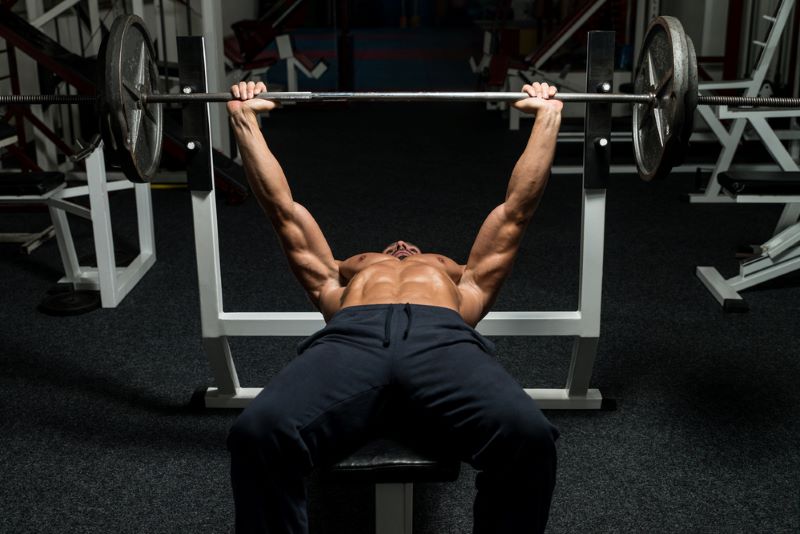If you’re wondering whether you can do chest and shoulders on the same day, then you’ve come to the right place!
In this article, we discuss the pros and cons of training chest and shoulders on the same day, which one should be trained first, and more!
Can You Do Chest And Shoulders On The Same Day?

You can do chest and shoulders on the same day and get some very good results from doing so.
The biggest issue though is that your chest and your shoulders are both considered pushing muscles. So they’ll be working together in many exercises.
Since bench press is arguably the most common chest exercise, doing this will not only work your chest to a high degree but it’ll also work your shoulders a great deal too.
This can be either positive or negative depending on what you’re hoping to achieve from your workout.
For example, if you want to do your chest and your shoulders in a single session, then both muscle groups working together can save you time as they can be worked harder with fewer exercises.
However, if you want to separate chest and shoulders into 2 sessions on the same day, then your shoulders may be too fatigued to perform to their best.
With all that being said, as long as you plan your workouts properly, doing chest and shoulders on the same day can be a very effective way of training your upper body.
(Watch below this epic chest and shoulder workout for maximum gains!)
Benefits Of Doing Chest And Shoulders On The Same Day
It Can Give Each Muscle Group More Recovery Time
One of the things that many gym-goers struggle with is allowing enough time in between workouts for specific muscle groups to fully recover.
For example, if you do chest on your first training day of the week, your shoulders would have already worked hard during that session.
If you then do back the next day, followed by arms, and then finally a session targeting your shoulders, your shoulders won’t actually have any recovery time as they’ll likely be working in all of these workouts.
By combining multiple muscle groups into one day, like your chest and your shoulders, you can give the working muscles more days to fully recover before having to start your training routine again the following week.
A few more days of recovery can actually make a big difference to muscle performance and growth during sessions.
It Saves Time
If there’s one obstacle that stops people from training as much as they would like, it would usually be time.
Trying to find the time to go to the gym so that you target each muscle group at least once can be very challenging for many of us.
However, combining muscle groups means you can end up having to go to the gym fewer times a week.
If you trained each muscle group individually, you’ll likely have to go to the gym between 5 and 7 times a week.
Doing multiple muscle groups on the same day, like chest and shoulders, can reduce this down to between 2 and 3 times.
This gives you more time outside of the gym to do all the other important things you have to do in life.
Drawbacks Of Doing Chest And Shoulders On The Same Day
Muscle Fatigue

As your chest and your shoulders work together in many exercises, there’s a possibility that your shoulders can get fatigued during chest exercises, resulting in poor performance during shoulder-specific exercises.
Your chest and shoulders are both push muscles, so they activate in many exercises together.
This can have a negative impact and lead to overtraining if you do them both on the same day without a well-planned training program.
More Time Needed In The Gym
Although doing chest and shoulders on the same day can save you time in regards to how often you have to go to the gym each week, it can mean that you have to spend longer in the gym on each training day.
If it takes you an hour to train your chest and another hour to train your shoulders, you’ll need to spend 2 hours in the gym to train both muscle groups effectively.
This isn’t always the case if you plan things well. But combining muscle groups into a single training day can lead to some extra-long workouts.
Should You Do Chest And Shoulders On The Same Day?
You certainly can do chest and shoulders on the same day, but it’ll depend on your fitness goals as to whether it’s the right thing to do for you or not.
Both muscle groups work closely together so you can target them both pretty well on the same day.
Can You Superset Chest And Shoulders?
Yes, you can superset chest and shoulders.
It will make for an extremely challenging (but effective) upper-body workout so, as long as you have the fitness and strength levels needed, supersetting these 2 muscle groups can work very well for you.
Should You Do Chest Or Shoulders First?
Usually, it’s a better idea to do shoulders after chest as your chest is the bigger muscle group.
This means you’ll be lifting more weight and will benefit from fresher muscles going into your chest-specific exercises.
As your shoulders will be assisting in many chest exercises, it’s a good idea to train them after chest as you’ll likely need good levels of support from your shoulders during the heavy chest exercises.
Should You Do Them In The Same Session Or 2 Sessions?
Either way is fine although it makes sense to do them both in the same session.
Your shoulders will be working hard during chest exercises anyway, so it could be a good idea to do some shoulder-specific exercises in the same session as your chest.
There’s no reason why you couldn’t split them into 2 sessions though.
Ultimately, it will come down to your fitness goals, fitness levels, and personal preferences as to whether you do them in the same session or 2 sessions.
How To Structure A Chest And Shoulder Workout
When it comes to planning a workout that combines chest and shoulders, it’s essential to consider several factors to ensure maximum effectiveness and safety.
Here are some tips on how to structure a chest and shoulder workout:
Warm-up
Before starting any workout, it’s crucial to warm up properly.
A warm-up should consist of some light cardio and mobility exercises that target the chest and shoulder muscles.
These exercises can include jumping jacks, arm circles, and shoulder rotations.
Compound Exercises
Compound exercises work multiple muscle groups at once and can be an effective way to train chest and shoulders together.
Some great compound exercises that target both chest and shoulders include push-ups, chest press, and shoulder press.
Isolation Exercises
Isolation exercises are exercises that target specific muscles.
Including isolation exercises in your workout routine can help to ensure that you’re targeting all of the smaller muscle groups effectively.
Some examples of isolation exercises for the chest and shoulders are chest flyes, lateral raises, and front raises.
Exercise Order
Exercise order can play a significant role in the effectiveness of your workout.
Generally, it’s best to start with compound exercises as they’re harder and require more energy.
Follow this up with isolation exercises to target the smaller muscles.
Rest Periods
Rest periods are an essential aspect of any workout routine.
For a chest and shoulder workout, it’s recommended to take a 60 to 90-second rest period between sets.
This rest period allows the muscles to recover and ensures that you can perform the next set with proper form and intensity.
Cool Down
After finishing your workout, it’s important to cool down properly to avoid injury and aid in recovery.
A good cool-down should consist of some light cardio and stretching exercises that target the chest and shoulder muscles.
This can include a brisk walk and stretches such as chest stretch and shoulder stretch.
How Often To Train Chest And Shoulders Together
The answer depends on your fitness goals, current fitness level, and training routine.
In general, it’s safe to train these muscle groups together up to two to three times per week, but it’s important to give your muscles ample time to rest and recover between workouts.
If you’re a beginner or intermediate lifter, starting with one to two chest and shoulder workouts per week is a good starting point. You can gradually increase the frequency as your strength and endurance improve.
For more advanced lifters or those with specific training goals, training chest and shoulders together can be done up to three times per week. However, it’s important to vary the exercises, sets, and reps in each workout to prevent overtraining and injury.
It’s also important to listen to your body and adjust your training frequency accordingly.
If you feel fatigued or experience muscle soreness or joint pain, take a break from training or reduce your training frequency
Conclusion
In summary:
- You can do chest and shoulders on the same day with minimal problems.
- If training this way, you should train your chest first followed by shoulders.
- Chest and shoulders can make a good superset workout.
That’s all for this article, but what about doing a back and shoulder workout on the same day? Or can you do chest and arms on the same day?
Hope this helped!
Sources
https://www.healthline.com/health/muscle-fatigue
I’ve been in the fitness and strength training industry for nearly a decade. In that time, I’ve gained 30 pounds of muscle, written hundreds of articles, and reviewed dozens of fitness supplements. As for my educational background, I’m a currently studying for my Active IQ Level 3 Diploma in Personal Training.

